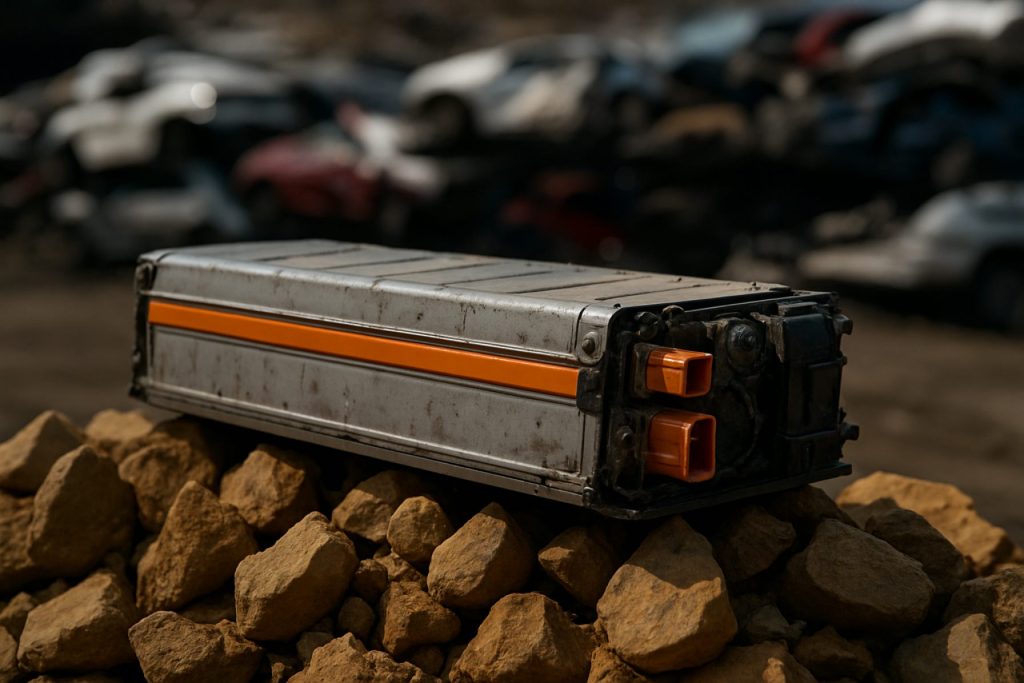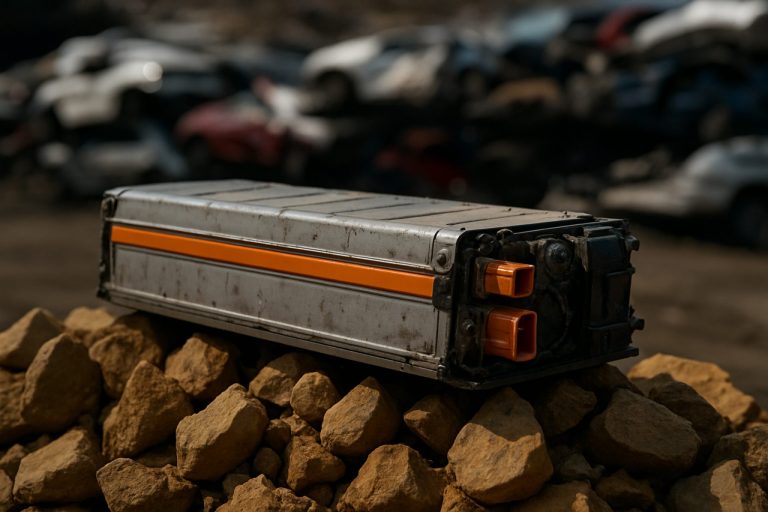
- The rapid increase in electric vehicles (EVs) is generating a massive wave of used lithium-ion batteries, turning battery recycling into a crucial industry.
- Key minerals—lithium, nickel, cobalt, and graphite—can be recovered from old batteries and reused to create new batteries and renewable technologies.
- Many EV batteries still retain 60%–80% capacity after automotive use, allowing for repurposing in energy storage or other applications before final recycling.
- Recycling reduces reliance on mining, helping to address environmental risks and ethical concerns linked to mineral extraction in places like Congo, Indonesia, and China.
- The battery recycling industry faces challenges, including high costs, technical barriers, and a shortage of specialized workers.
- Investing in battery reuse and recycling is essential for environmental sustainability, economic security, and technological independence as EV adoption accelerates.
A surge of electric vehicles motor onto roads worldwide, drawing eyes to their glittering potential—and creating a hidden treasure in their wake. As millions of drivers swap gasoline for quiet, battery-powered rides, a seismic shift begins beneath the surface: used lithium-ion batteries, once destined for landfill or obscurity, are emerging as the next critical resource.
Cracking open one of these spent batteries reveals more than just tangled circuitry—it yields minerals as precious as gold in today’s technology-fueled economy. Lithium, nickel, cobalt, graphite: all crucial to building the next generation of batteries, smartphones, and wind turbines. With over 17 million electric and hybrid vehicles sold in 2024 and projections climbing higher for 2025, the sheer volume of soon-to-retire batteries is staggering. Nearly 20% of every new car sold now is electric, a number set to rise as bold government climate policies muscle combustion engines out of the picture.
What most drivers don’t realize: even “dead” batteries retain a surprising punch. Many end their car lives with 70% or more of their original capacity intact—enough to light up homes during a blackout, balance a city’s electrical grid, or power up smaller vehicles. Reused in these ways, they become both environmental champions and economic drivers.
The path from old battery to new resource isn’t simple. High-capacity packs can often be reconditioned or refitted for similar vehicles. Those with moderate life left—between 60% and 80%—find new purpose storing solar energy or powering industrial machines. Even packs considered spent, dropping below 60% health, aren’t waste: they’re shredded and processed into “black mass,” a raw material rich in future-proof minerals.
The stakes are global. Most of the world’s cobalt comes from the Democratic Republic of Congo, a nation wrestling with human rights issues while meeting Western demand. Indonesia dominates nickel, and China controls a lion’s share of mining and processing. Scrapping batteries without recovery means greater pressure on vulnerable environments and communities—and deeper reliance on unpredictable geopolitics.
Recycling isn’t science fiction anymore. In North America, Li-Cycle builds sprawling plants to rip apart and separate used batteries, backed by U.S. government incentives. British innovators like Altilium have opened facilities once hamstrung by the pandemic but now humming with new life. According to a European green transport federation, recycled batteries by 2030 could supply up to a quarter of the region’s cobalt needs and substantial shares of lithium, nickel, and manganese—enough to build millions of new EVs each year.
Yet major hurdles lie ahead: high costs, technical complexity, and a global shortage of experts slow the pace of progress. Policymakers and business leaders face an urgent imperative—to forge stronger incentives, invest in specialized skills, and drive the maturation of battery recycling ecosystems.
Here’s the key takeaway: the batteries powering today’s electric revolution hold tomorrow’s mineral wealth. To waste them is to squander a chance at environmental salvation, economic resilience, and technological independence. As the world pushes ahead with electrification, investing in battery reuse and recycling isn’t just a smart move—it’s essential for a sustainable future.
For more on the global shift to sustainable technologies, visit Bloomberg or dig deeper into energy innovations at Reuters.
Why Old Electric Car Batteries Are the Gold Rush of a Greener Tomorrow: Shocking Facts, Hidden Challenges & Immediate Hacks
The Hidden Value in Spent EV Batteries: Game-Changer for Tech, Policy, and the Environment
The electric vehicle (EV) revolution isn’t just transforming what we drive—it’s creating a hidden fortune inside the very batteries that powered your last road trip. While much of the conversation has centered on the shiny, futuristic cars themselves, the afterlife of their lithium-ion batteries is setting the stage for a high-stakes race in recycled minerals—a critical move for technology, sustainability, and supply chain security.
Below, we uncover lesser-known facts about used EV batteries, practical solutions for consumers and industry, market trends, and looming controversies—so you can stay ahead as this high-voltage sector charges forward.
—
Fast Facts Electric Car Owners and Investors Need to Know
1. Second-Life Applications Are Booming—Not Just Recycling
– “Dead” EV batteries often retain 60–80% of their charge capacity and are increasingly repurposed for:
– Home battery storage (powering your house, especially with solar).
– Grid-scale energy storage (helping balance renewable power supply and demand spikes).
– Powering electric buses, forklifts, and smaller vehicles.
– Example: Nissan and Renault have launched projects turning retired batteries into backup systems for stadiums and apartment complexes.
2. Battery Chemistries Create Unique Opportunities and Risks
– Not all lithium-ion batteries are the same—lithium iron phosphate (LFP) batteries are cheaper and more fire-resistant than nickel-manganese-cobalt (NMC), but LFPs contain less valuable metals for recycling.
– Newer batteries are moving away from cobalt for ethical reasons. LFP and sodium-ion chemistries will impact future recycling economics ([source](https://www.bloomberg.com)).
3. The “Urban Mining” Boom
– “Urban mining”—extracting valuable metals from used products—is projected to create a more stable and environmentally responsible supply chain versus traditional mining.
– By 2040, recycled metals could meet 40% of battery manufacturing needs, reducing reliance on new mining ([International Energy Agency](https://www.iea.org)).
4. Key Industry Players and Technology Innovations
– Li-Cycle (Canada/US), Redwood Materials (US), and Umicore (Europe) lead in advanced hydrometallurgical processes (low-energy, high-recovery).
– Closed-loop solutions are being piloted by major automakers: Tesla, Ford, and others now aim to recycle old batteries into new EVs.
5. Regulatory Shake-Ups
– The EU Battery Directive now mandates recycling targets for lithium (35% by 2026, 70% by 2030) and other metals ([European Commission](https://ec.europa.eu)).
– California requires battery manufacturers to take on end-of-life responsibility by 2026 ([Reuters](https://www.reuters.com)).
—
Real-World How-To: What Should Consumers Do with Spent Battery Packs?
Step-by-Step Guide:
1. Contact your automaker or dealership—many now offer battery take-back programs.
2. If DIY removal (not recommended), always follow local hazardous waste regulations.
3. Search for certified e-waste recyclers with battery processing capability.
4. Explore second-life uses if your battery is above 70% capacity—companies like RePurpose Energy and B2U Storage can help repurpose for home or business storage.
Life Hack:
Never store old batteries in garages or basements—they pose fire risks. Always consult local recycling authorities!
—
Pros & Cons: Is Battery Recycling Worth the Hype?
| Pros | Cons |
|—————-|————–|
| Reduces e-waste and landfill risk | High cost due to technical complexity |
| Cuts dependence on conflict minerals | Some batteries (LFP) offer less valuable metals |
| Saves energy compared to raw mining | Safety hazards in handling and transit |
| Can stabilize mineral prices | Industry faces skills shortage and regulations lag |
—
Controversies, Limitations, and Security Concerns
– Safety Hazards: Damaged batteries can catch fire (“thermal runaway”). Shipping and storage are tightly regulated.
– Environmental Risk: Poorly managed facilities could leak toxic chemicals.
– Supply Chain Transparency: Many “recycled” batteries are illegally exported to developing countries, risking pollution and labor abuses (Amnesty International, 2023).
– Data Security: Batteries sometimes retain system data—proper data wiping is critical.
—
Market Forecasts & Industry Trends
– The global EV battery recycling market is projected to surpass $18 billion by 2030 (Allied Market Research).
– “Battery passport” regulation—track battery mineral content/ownership for recycling—will likely be adopted globally.
– Growing shift to automated and AI-driven sorting processes to boost recovery rates and safety.
—
Most Pressing Questions from Readers
Q: How much of a battery’s minerals can really be recovered?
A: Modern hydrometallurgical recycling processes recover 95%+ of cobalt, nickel, and copper, and 80–90% of lithium.
Q: Will recycled batteries perform as well as new?
A: While “second-life” batteries are not suitable for powering new EVs, they’re overqualified for stationary storage and can last for another 5–10 years.
Q: How can consumers ensure responsible recycling?
A: Choose certified recyclers and request a recycling certificate—track compliance with EU and state regulations.
—
Actionable Recommendations & Quick Tips
– Check if your car’s manufacturer offers direct battery recycling or resale incentives.
– Sign up for local EV owner groups—they often coordinate responsible e-waste disposal.
– If running a business, consider investing in second-life storage batteries—they’re cheaper and greener than new ones.
– Watch for incentives or tax breaks under new clean energy bills targeting battery recycling (consult local government sites for updates).
—
Conclusion: Don’t Let EV Batteries Go to Waste!
As electric vehicles thunder onto roads worldwide, smart recycling and reuse of retired batteries are crucial for environmental progress, ethical sourcing, and economic resilience. Stay informed, support responsible recycling, and you’ll be riding the green wave into a brighter, more sustainable future.
Stay updated on tech and global trends with trusted sources like Bloomberg and Reuters.
Keywords: EV battery recycling, lithium-ion, second-life batteries, circular economy, e-waste, sustainable technology, mineral supply chain, battery regulations, urban mining, green energy storage



